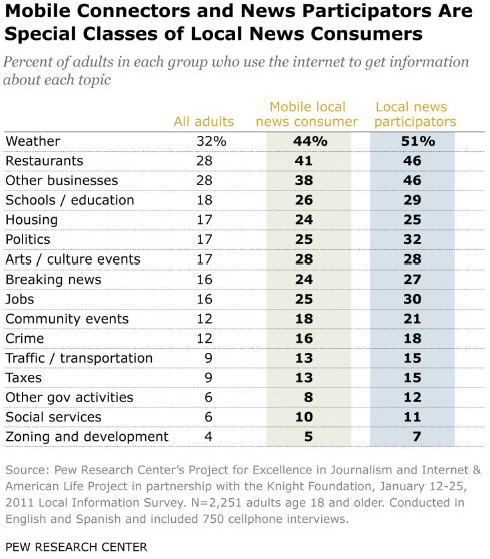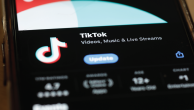Two other factors seem to drive people to the internet when it comes to getting information about local subjects: mobile connections via smartphones or tablet computers and participation in the digital environment by sharing or creating local material themselves.
Mobile and participatory news consumers
This survey measured mobile local news and information access by asking questions about how people used smartphones and tablets. In all, 47% of adults get at least some local news and information via their smartphones or tablet computers.10 Thus, while mobile does not top the list of preferred sources for any of the 16 topics asked about, it is clearly a widely used supplemental source. Specifically:
- 36% of all adults said they used a smartphone or tablet computer to check weather reports
- 31% of all adults said they used those mobile devices to find local restaurants or local businesses
- 25% of all adults said they used those mobile devices to get news about their local community
- 20% of all adults said they used those mobile devices to check local sports scores and get updates
- 19% of all adults said they used those mobile devices to get information about local traffic or public transportation
- 16% of all adults said they used those mobile devices to get or use coupons for discounts at local stores
In addition, 13% of adults say they get news alerts about their community sent to their phones by text messages or email. And 11% of adults say they get local news from apps for their smartphones.
On the participatory side, 41% of adults can be considered “local news participators.” That means they said “yes” to at least one of the following:
- 25% of adults share links to local stories or videos online with others
- 16% of adults have commented on local news stories or blogs they read online
- 16% of adults have posted news or information about their local community on a social networking site like Facebook
- 8% of adults contribute to online discussions or message boards about their community
- 6% of adults have “tagged” or categorized online local news content
- 5% of adults have contributed articles, opinion pieces, photos or videos about their local community online
- 2% of adults have posted news or information about their local community on Twitter
Interestingly, though, online social networks have yet to become a main source for most areas of local information. Only very small percentages named social networks as the places they turn to most for any of the 16 topics areas. For instance, the topics on which social networks ranked highest were local restaurants and community events, with just 2% of adults naming these sites as a key source. For the other 14 types of community news and information, social networks were cited even less often.
If someone is interested in getting local information on a handheld device or participates in circulating local information, she is significantly more likely than others to say she relies on the internet for most of the topics we explored. This is particularly true for participators, who are enthusiastic news consumers with more wide-ranging appetites than other local information consumers.

The unknown direction of apps culture
One major unknown in the future is how powerful mobile device apps will become in delivering content that people want about their communities. At the moment, apps use barely registered on any subject in the survey.
The main indicator of the potential future of apps comes in getting the weather: 5% of adults say they rely most on a mobile app for getting such information. But in every other subject, 1% or less of the adult population cited apps as a key source. However, it is easy to imagine a scenario where apps become highly useful – and highly used – for several of these local topics in the future, including traffic, breaking news, restaurants, neighborhood events and local cultural events (on a topic-driven community calendar), schools and education, and even social services.




